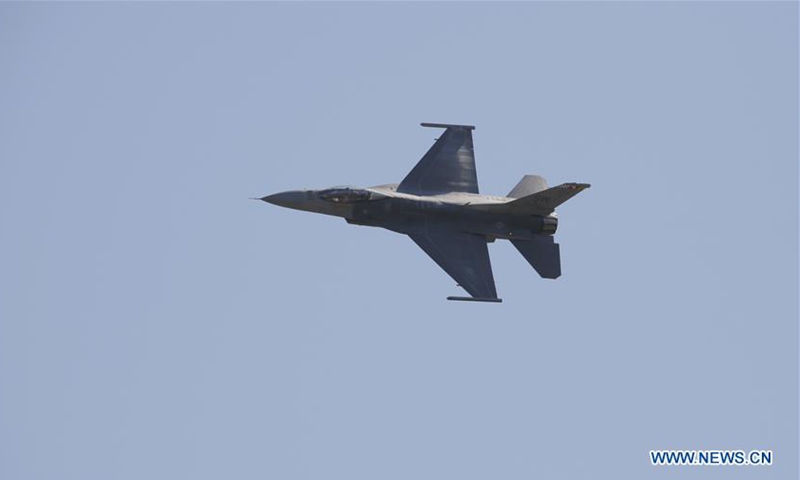Blaming PLA for fighter jet missing an excuse for weak Taiwan military capacity
By Leng Shumei Source: Global Times Published: 2020/11/18 23:22:34

An F-16 fighter jet performs at the air show in Houston, the United States, on Oct. 10, 2020. The annual Wings Over Houston Airshow kicked off at the Ellington Airport on Saturday with thrilling aerial performances and displays. Visitors were asked to drive their cars to the show field and stay close to the cars during the show amid the COVID-19 pandemic. (Photo by Lao Chengyue/Xinhua)
Media on the island of Taiwan, citing a retired senior pilot, said that the missing of an F-16 fighter jet on the island on Tuesday was due to increasing pressure on the island's air force because of frequent visits by People's Liberation Army (PLA) planes to the island, which mainland military experts say is only an excuse for the island's untenable military capacity.
The accident happened late on Tuesday two minutes after the plane took off from a base in Hualien for routine training.
It was only 20 days after the crash of an F-5E fighter jet on the island on October 29 due to engine failure. The pilot in that plane was still missing, and search and rescue work was still in process.
A retired Taiwan senior pilot surnamed Tsai told media that he thinks the frequent accidents probably were caused by rising pressure brought about by the PLA's constant visits to the island recently, which led to increasing training and fatigue for the pilots.
However, deputy director of the Taiwan military department Chang Che-ping denied that possibility to the media, noting that the accident was highly likely caused by mechanical factors.
He also noted that the aircraft that Taiwan used to react to the visits of the PLA aircraft were based in the south at Chiayi, rather than Hualien.
Taiwan started to purchase 150 F-16 jets from the US in 1992, and first used them in the military in 1997. Besides the one that crashed on Tuesday, eight other F-16 jets crashed between 1997 and 2020.
Most of the crashes happened during night training at sea, and it's easy to encounter spatial disorientation, leading pilots to confuse the sea with the sky. This could be the reason for the Tuesday accident, according to Song Zhongping, a Chinese mainland military observer.
Insufficient maintenance of the jets could also lead to machine failure, resulting in an accident, Song told the Global Times on Wednesday.
The PLA reportedly sent warplanes to the Taiwan Straits on at least 25 days out of the total of 31 days in October.
The PLA warplanes entered the straits twice on Wednesday, according to Taiwan media.
In response to the Taiwan retired senior pilot blaming the PLA for the accident, Song said this is an excuse for the island's lack of regular training, as it was busy reacting to the PLA's moves.
He noted Taiwan's failure to ground F-5E jets for examination after the accident in late October, as it sent another F-5E into training only two weeks later. This revealed that the island does not have a system to review and evaluate accidents.
"The Taiwan military's training level and capacity are actually minor compared with the PLA," Song noted.
The island's military department announced on Wednesday plans to ground all F-16 jets for examination and replace them with Indigenous Defence Fighter (IDF) planes, Taiwan media reported, citing the local military department.
The IDF's capacity is far from the F-16, so replacing the F-16 in that way would only make the Taiwan air force's capacity even weaker, mainland military analysts said.
Posted in: MILITARY